| Article ID | Journal | Published Year | Pages | File Type |
|---|---|---|---|---|
| 6727362 | Energy and Buildings | 2018 | 23 Pages |
Abstract
A simple way to reduce energy consumption is to minimize heating use during unoccupied periods. This implies the possibility of adjusting the room temperature setpoint. However, systems with a large thermal capacity cannot follow sudden setpoint changes because of their thermal inertia. A model predictive control (MPC) allows the harnessing of this inertia in order to reduce heating costs and improve comfort. This advanced control technique is based on disturbances anticipation (occupation, weather conditions) and requires a model of the system which has to be controlled. Therefore, the use of such controller needs a reliable model that describes well the dynamics of the room on upcoming days. This paper presents a method for the selection of the model (type, level of complexity) to be implemented in a MPC controller to anticipate the control of a long time response floor heating system on a real building. The demonstration room and embedded systems serving as experimental support are presented. Short measurement periods are carried out to identify the model parameter values minimizing the gap between model output and measurement. Gray-box models based on electrical analogy and state-space representation are proposed. They are constructed from physical knowledge and then identified by choosing the most appropriate measurement series. A sensitivity analysis method (Morris) is used to improve the quality of the identified model which satisfies control criteria with two specific validation measurement series. In a complementary paper, the predictive controller integrating the selected model is compared to more conventional management strategies in simulation and on-site with the experimental building.
Related Topics
Physical Sciences and Engineering
Energy
Renewable Energy, Sustainability and the Environment
Authors
H. Viot, A. Sempey, L. Mora, J.C. Batsale, J. Malvestio,
